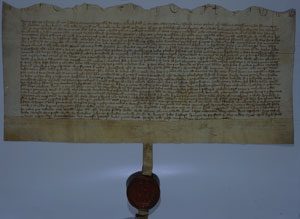 |
 |
 |
 |
 |
 |
 |
|
Internal life (4/7) With the demise of the lay-brothers from the late thirteenth century there were changes to the internal structure of the abbey. This was part of a general pattern experienced in all Cistercian houses at this time prompted by the changing economic situation and exacerbated by the Black Death. Whilst we do not know the exact number of monks and lay-brothers who lost to the plague, the fact that four abbots presided during the period 1348-55 and that by 1381 there were only sixteen monks and six lay-brothers, suggests that it took its toll.(27) The demise of the lay-brethren altered the organisation of space; for example, as their choir stalls in the western half of the church were essentially unused they were pulled out and replaced by altars. Another direct consequence of their demise was the leasing out of abbey lands, which was carried out extensively from 1288-1459. With the loss of manpower Kirkstall could no longer directly exploit all its lands; it was also hoped that the leasing out of lands would increase their value. From c. 1305-1440 the structure of the community was also affected by the presence of one or two corrodians, usually retired royal servants sent by the king to reside within the precinct. The monks objected to the financial imposition caused by these residents, and in the mid-fourteenth century the abbot of Kirkstall requested that the king release them from this burden; his petition, however, fell on deaf ears.(28) |
||
|
|
